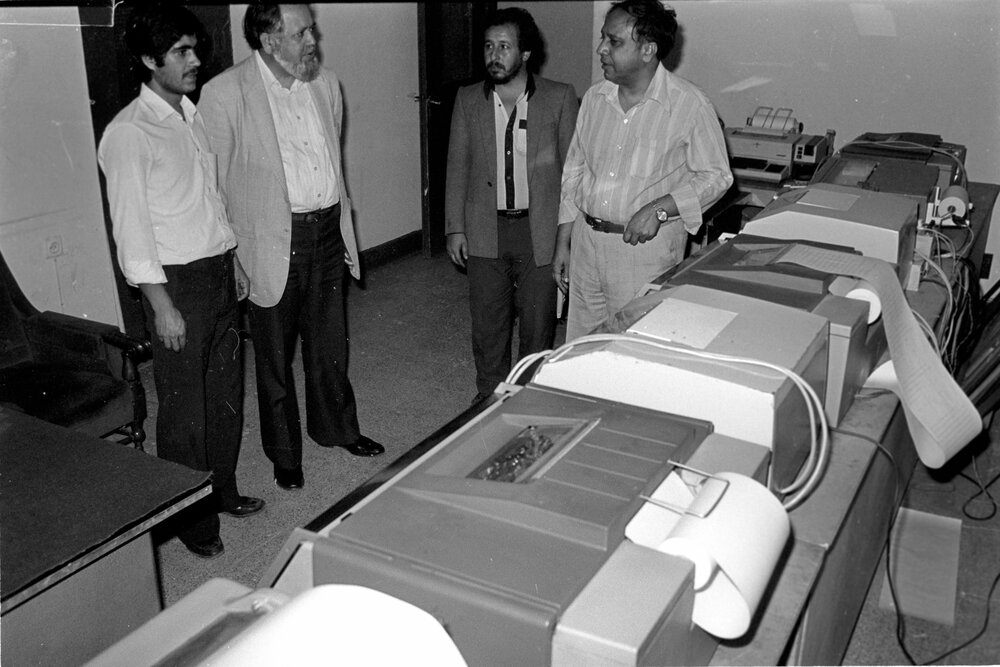Educational passage through Tehran Times
Transition to digital media revolution

The first message over a telegraph line was sent in 1844 by inventor Samuel F.B. Morse from Washington to Baltimore: “What hath God wrought?”
Communication industry has evolved during the digital revolution, making print media more and more a member of endangered species.
Prior to the 1979 Islamic Revolution, there were two English language newspapers published from Tehran: The Tehran Journal published by the Ettela’at Institution group and Kayhan International by the Kayhan Institute. After the revolution both papers seized to exist and there was a void of news from Tehran in English language for the world.
Irfan Parviz migrated to Iran in 1969 from his native town of Bhopal in India. Tehran Times was founded some two months after the 1979 Islamic Revolution. The first license holder and editor-in-chief of the newspaper was my father Irfan Parviz. Abbas Barazandeh was Mr. Irfan’s partner and friend and was one of the co-founders of the daily.
I was sixteen years old at the time and due to the revolution all public schools were closed and I had to put my high school diploma project on hold and join my pioneer father. Indeed all members of Mr. Irfan’s family were involved with the daily at one point or another.
When I walked in the first office of the Tehran Times on Fatemi St. the office atmosphere was electrifying, buzzing with the sound of manual typewriters with so many people working to produce the first edition.
There were four mechanical telex machines clicking away 24/7 for the four news agencies: AP, UPI, Reuters, and AFP. The noisy telex room was managed by one person who would select and sort the news and classify according to category.
I had the privilege to visit Ettela’at printing press typesetting division in 1976 with Mr. Irfan. The mechanical typesetting machines almost the size of an automobile where the typographer would sit and input information character by character manually. It was very time and space consuming procedure.
Tehran Times' first edition was printed on May 4, 1979. By then the typesetting procedures had been revolutionized by IBM electronic composer machines. These machines were a fusion of mechanical and electronic innovation. With a series of impressive choices in typefaces and a memory of about 500 words the IBM composer machines were an extension of an electronic typewriter but with memory. Electronic typewriters eventually made manual machines an antique item.
IBM composers were limited by the size of the typeface (max size 12 point) and memory capacity. So the headlines with larger typefaces were done by hand using lettraset types.
Writing procedure was done on a manual/electric typewriter, where editing and rewriting is not possible. Once a report had been written and typed, it went to the sub-editor for a lookover and then sent to the typesetters using IBM composers. The print out from the first version would be proofread and when final corrections were done a final printout was sent to the graphic artists for paste up.
The graphic artist would paste the news print on a thick paper using cutters and scissors and glue. The final product would go to the printing press.
As the printing industry digitized many professions in the print industry became obsolete.
When the newspaper moved two its third location (Khosrow St. and Villa St.) the devastating Iraq-Iran had started in 1980 and the whole city of Tehran would be faced with frequent blackouts due to aerial attacks. However, many of the newspaper’s work wouldn’t stop as the writers would turn to manual typewriters, graphic artists would use candles or lanterns and the work would go on.
During Tehran Times’ early years Mr. Irfan would have regular meetings with Ayatollah Mohammed Beheshti regarding the policies of the daily. At one point martyr Beheshti’s statement about the daily: “The Tehran Times is not the newspaper of the government. It must be a loud voice of the Islamic Revolution and the loudspeaker of the oppressed people of the world”.
Just as today we are faced with the coronavirus pandemic, the early years of the revolution the Islamic Republic was faced with another virus called “terrorism”. Ayatollah Beheshti fell victim to this type of virus when he was assassinated along with more than 70 members of the Islamic Republic Party on June 28, 1981.
By 1982 the internet revolution had already started and Seyed Hussain Mousavian was the first Managing Director under the Tablighat-e Islami. There were plans of publishing the Tehran Times from India and several trips were made by Messrs Irfan and Mousavian to India to check out the prospects of publishing from New Delhi. The internet revolution changed all that.
Working for Tehran Times so early on is one of my best experiences as a teenager. Those years I didn’t miss school. Seeing the post-revolutionary era through the eyes of the Tehran Times was itself an education.
On behalf of my family: Many happy returns of the day to the Tehran Times.
Leave a Comment